Analysis of Determinants of the Impact and the Grid Capability to Evaluate and Improve Grid Resilience from Extreme Weather Event
Abstract
:1. Introduction
2. Determinants of the Impact and the Grid Capability
2.1. The Impact
2.2. The Grid Capability
- (1)
- Absorptive, which is the ability of the grid to minimize the disruption from the initial attack.
- (2)
- Adaptive, which is the ability of the grid to keep operating under the damaged state.
- (3)
- Restorative, which is the ability of the grid to restore to full functionality after the attack.
3. Grid Resilience Assessment
3.1. Assessment of the Impact Determinants
3.1.1. Extreme Weather Events
3.1.2. Grid Exposure
3.1.3. Grid Vulnerability
3.2. Assessment of the Grid Capability Determinants
3.2.1. Physical Durability
3.2.2. Operational Versatility
3.2.3. Rehabilitation Capacity
4. Grid Resilience Improvement
4.1. Improving Physical Durability
- Elevated substation: this reduces substation exposure from flooding by elevating the substation above the inundation limit [84].
- Substation relocation: this moves the substation to a more secure area (low probability of extreme weather events).
- Utilization of sensors technology: this provides enough time to prepare the prevention action as early as possible when extreme weather events are coming [85].
- Equipment and component revitalization: this is to maintain equipment physical properties and functionalities [84]. Equipment physical properties and functionalities decrease with age. Even though the equipment was designed to withstand certain disruptions, it will decrease after being used close to its lifetime [55].
- Application of hydrophobic coating: this helps components to shed precipitation, mitigate water damage, and facilitate ice removal [85].
- Building earthquake-resistant substation: the design of earthquake-resistant buildings has been developed, and it can be applied to the design the substations located where a high probability of earthquakes occurs.
- Routine maintenance: this maintains the physical structure and functionalities of equipment [4].
4.2. Improving Operational Versatility
- Network redundancy: this provides several alternative lines to supply electricity to the area having a high probability of extreme weather occurrence. Although one line is damaged, it can still supply the power through the alternative lines.
4.3. Improving Grid Rehabilitation Capacity
- Utilization of extreme weather event logging database: this is the most important to improve grid rehabilitation capacity [85,92]. It contains all the records of the previous event, including the remedy strategies so that it can be used to forecast the future disruptions and analyze the effectiveness and efficiency of remedial actions to be taken by simulations.
- Modification of the system to be resilient: it is done based on the lesson learned from previous disruptions.
- Review and revise design standards, construction guidelines, and maintenance procedure: since extreme weather events tend to increase in the future, some of standards, guidelines, and procedures need to be upgraded to accommodate those situations [83].
5. Conclusions
Acknowledgments
Author Contributions
Conflicts of Interest
References
- Abi-samra, N.C. One Year Later: Superstorm Sandy Underscores Need for a Resilient Grid. Available online: https://spectrum.ieee.org/energy/the-smarter-grid/one-year-later-superstorm-sandy-underscores-need-for-a-resilient-grid (accessed on 8 January 2017).
- Ton, D. DOE Microgrid Program Microgrid Controllers. Available online: https://www.ll.mit.edu/mission/engineering/Symposium/2017/1-MDCS-KEYNOTE-DOE-Microgrid-Program-Microgrid-Controllers.pdf (accessed on 22 February 2017).
- Chaudry, M.; Ekins, P.; Ramachandran, K.; Shakoor, A.; Skea, J.; Strbac, G.; Wang, X.; Whitaker, J. Building a Resilient UK Energy System. Available online: http://www.ukerc.ac.uk/support/tiki-download_file.php?fileId=618 (accessed on 12 January 2017).
- Campbell, R.J. Weather-Related Power Outages and Electric System Resiliency; Congressional Research Service: Washington, DC, USA, 2012. [Google Scholar]
- Venkata, S.S.M.; Hatziargyriou, N. Grid Resilience: Elasticity Is Needed When Facing Catastrophes. IEEE Power Energy Mag. 2015, 13, 16–23. [Google Scholar] [CrossRef]
- Panteli, M.; Mancarella, P. The Grid: Stronger, Bigger, Smarter? IEEE Power Energy Mag. 2015, 13, 58–66. [Google Scholar] [CrossRef]
- Economic Benefits of Increasing Electric Grid Resilience To Weather Outages. Available online: https://energy.gov/downloads/economic-benefits-increasing-electric-grid-resilience-weather-outages (accessed on 22 February 2017).
- Simpson, M.J. Global Climate Change Impacts in the United States. J. Environ. Qual. 2011, 40, 279. [Google Scholar] [CrossRef]
- Lerner-Lam, A. Assessing global exposure to natural hazards: Progress and future trends. Environ. Hazards 2007, 7, 10–19. [Google Scholar] [CrossRef]
- Kezunovic, M.; Dobson, I.; Dong, Y. Impact of Extreme Weather on Power System Blackouts and Forced Outages: New Challenges. In Proceedings of the 7th Balkan Power Conference, Laboratory of Energy Policy, University of Ljubljana, Šibenik, Croatia, 10–12 September 2008; pp. 1–5. [Google Scholar]
- Ton, D.T.; Wang, W.P. A More Resilient Grid. IEEE Power Energy Mag. 2015, 13, 26–34. [Google Scholar] [CrossRef]
- IEEE Std 1366TM-2012—IEEE Guide for Electric Power Distribution Reliability Indices. Available online: http://ieeexplore.ieee.org/stamp/stamp.jsp?tp=&arnumber=6329910 (accessed on 22 February 2017).
- Presidential Policy Directive 21—Critical Infrastructure Security and Resilience. Available online: https://obamawhitehouse.archives.gov/the-press-office/2013/02/12/presidential-policy-directive-critical-infrastructure-security-and-resil (accessed on 3 February 2017).
- Intergovernmental Panel on Climate Change (IPCC); Field, C.B.; Barros, V.; Stocker, T.F.; Qin, D.; Dokken, D.J.; Ebi, K.L.; Mastrandrea, M.D.; Mach, K.J.; Plattner, G.-K.; et al. Managing the Risks of Extreme Events and Disasters to Advance Climate Change Adaptation; Cambridge University Press: Cambridge, UK; New York, NY, USA, 2012. [Google Scholar]
- Keeping the Country Running: Natural Hazards and Infrastructure. Available online: https://www.gov.uk/government/publications/keeping-the-country-running-natural-hazards-and-infrastructure (accessed on 22 February 2017).
- Hov, Ø.; Cubasch, U.; Fischer, E.; Höppe, P.; Iversen, T.; Kvamstø, N.G.; Kundzewicz, Z.W.; Rezacova, D.; Rios, D.; Santos, F.D.; et al. Extreme Weather Events in Europe: Preparing for Climate Change Adaptation; Norwegian Meteorological Institute: Oslo, Norway, 2013.
- Chang, M. Making the Grid More Resilient within Reason; Synapse Energy Economics, Inc.: Cambridge, MA, USA, 2014. [Google Scholar]
- Watson, J.P.; Guttromson, R.; Silva-Monroy, C.; Jeffers, R.; Jones, K.; Ellison, J.; Rath, C.; Gearhart, J.; Jones, D.; Corbet, T.; et al. Conceptual Framework for Developing Resilience Metrics for the Electricity, Oil, and Gas Sectors in the United States; Sandia National Laboratoories: Albuquerque, NM, USA; Livermore, CA, USA, 2015.
- Wisner, B.; Blaikie, P.; Cannon, T.; Davis, I. AT RISK; Taylor & Francis: Abingdon, UK, 1994; Volume 24, ISBN 978-0-203-44423-8. [Google Scholar]
- Crichton, D. The risk triangle. In J. Ingleton (ed). Natural Disaster Management; Tudor Rose: London, UK, 1999; pp. 102–103. ISBN 0-9536140-1-8. [Google Scholar]
- Proag, V. Assessing and Measuring Resilience. Procedia Econ. Financ. 2014, 18, 222–229. [Google Scholar] [CrossRef]
- Hosseini, S.; Barker, K.; Ramirez-Marquez, J.E. A review of definitions and measures of system resilience. Reliab. Eng. Syst. Saf. 2016, 145, 47–61. [Google Scholar] [CrossRef]
- Francis, R.; Bekera, B. A metric and frameworks for resilience analysis of engineered and infrastructure systems. Reliab. Eng. Syst. Saf. 2014, 121, 90–103. [Google Scholar] [CrossRef]
- Panteli, M.; Mancarella, P.; Wilkinson, S.; Dawson, R.; Pickering, C. Assessment of the resilience of transmission networks to extreme wind events. In Proceedings of the 2015 IEEE Eindhoven PowerTech, Eindhoven, The Netherlands, 29 June–2 July 2015. [Google Scholar] [CrossRef]
- Panteli, M.; Mancarella, P. Modeling and Evaluating the Resilience of Critical Electrical Power Infrastructure to Extreme Weather Events. IEEE Syst. J. 2017, 11, 1733–1742. [Google Scholar] [CrossRef]
- Wang, B.; Zhou, Y.; Mancarella, P.; Panteli, M. Assessing the impacts of extreme temperatures and water availability on the resilience of the GB power system. In Proceedings of the 2016 IEEE International Conference on Power System Technology (POWERCON), Wollongong, Australia, 28 September–1 October 2016; pp. 1–6. [Google Scholar] [CrossRef]
- Panteli, M.; Pickering, C.; Wilkinson, S.; Dawson, R.; Mancarella, P. Power System Resilience to Extreme Weather: Fragility Modeling, Probabilistic Impact Assessment, and Adaptation Measures. IEEE Trans. Power Syst. 2017, 32, 3747–3757. [Google Scholar] [CrossRef]
- Cadini, F.; Agliardi, G.L.; Zio, E. A modeling and simulation framework for the reliability/availability assessment of a power transmission grid subject to cascading failures under extreme weather conditions. Appl. Energy 2017, 185, 267–279. [Google Scholar] [CrossRef]
- Penkey, P.; Alla, M.; Johnson, B.K.; McJunkin, T.R. Improving transmission system resilience using an automation controller and Distributed Resources. In Proceedings of the 2016 Resilience Week (RWS), Chicago, IL, USA, 16–18 August 2016; pp. 89–94. [Google Scholar] [CrossRef]
- Ma, S.; Chen, B.; Wang, Z. Resilience Enhancement Strategy for Distribution Systems under Extreme Weather Events. IEEE Trans. Smart Grid 2016. [Google Scholar] [CrossRef]
- Henry, D.; Emmanuel Ramirez-Marquez, J. Generic metrics and quantitative approaches for system resilience as a function of time. Reliab. Eng. Syst. Saf. 2012, 99, 114–122. [Google Scholar] [CrossRef]
- Ayyub, B.M. Systems resilience for multihazard environments: Definition, metrics, and valuation for decision making. Risk Anal. 2014, 34, 340–355. [Google Scholar] [CrossRef] [PubMed]
- Abi-Samra, N.C. Sample Effects of extreme weather on power systems and components, part I: Sample effects on distribution systems. In Proceedings of the 2010 IEEE Power and Energy Society General Meeting, Providence, RI, USA, 25–29 July 2010; pp. 1–3. [Google Scholar] [CrossRef]
- Abi-Samra, N.C.; Malcolm, W.P. Extreme weather effects on power systems. In Proceedings of the 2010 IEEE Power and Energy Society General Meeting, Detroit, MI, USA, 24–29 July 2011; pp. 1–5. [Google Scholar] [CrossRef]
- Kenward, A.; Raja, U. Blackout: Extreme Weather, Climate Change and Power Outages; Climate Central: Princeton, NJ, USA, 2014. [Google Scholar]
- Fact sheet 6—The Beaufort Scale. Available online: https://www.metoffice.gov.uk/binaries/content/assets/mohippo/pdf/b/7/fact_sheet_no._6.pdf (accessed on 22 February 2017).
- Park, Y.J.; Glagola, C.R.; Gurley, K.R.; Son, K. Performance assessment of the Florida electric-power network system against hurricanes. Nat. Hazards Rev. 2014, 15, 1–7. [Google Scholar] [CrossRef]
- Saffir-Simpson Hurricane Wind Scale. Available online: http://www.nhc.noaa.gov/aboutsshws.php (accessed on 9 February 2017).
- Spence, W.; Sipkin, S.A.; Choy, G.L. Measuring the Size of an Earthquake. Available online: https://earthquake.usgs.gov/learn/topics/measure.php (accessed on 30 March 2017).
- Floods, The Awesome Power. Available online: http://www.nws.noaa.gov/floodsafety/resources/FloodsTheAwesomePower_NSC.pdf (accessed on 22 February 2017).
- National Weather Service. Thunderstorms, Tornadoes, Lightning: Nature’ s Most Violent Storms. Available online: https://www.weather.gov/media/owlie/ttl6-10.pdf (accessed on 22 February 2017).
- National Weather Service NWS Heat Safety Safety Home Page. Available online: http://www.nws.noaa.gov/om/heat/heat_index.shtml (accessed on 14 August 2017).
- Coles, S. An Introduction to Statistical Modeling of Extreme Values, 1st ed.; Springer: London, UK, 2001. [Google Scholar]
- Bouwer, L.M. Projections of Future Extreme Weather Losses Under Changes in Climate and Exposure. Risk Anal. 2013, 33, 915–930. [Google Scholar] [CrossRef] [PubMed]
- Component of Risk: Exposure. Available online: http://www.preventionweb.net/risk/exposure (accessed on 22 February 2017).
- Han, S.R.; Guikema, S.D.; Quiring, S.M. Improving the predictive accuracy of hurricane power outage forecasts using generalized additive models. Risk Anal. 2009, 29, 1443–1453. [Google Scholar] [CrossRef] [PubMed]
- Schlögl, M.; Laaha, G. Extreme weather exposure identification for road networks—A comparative assessment of statistical methods. Nat. Hazards Earth Syst. Sci. 2017, 17, 515–531. [Google Scholar] [CrossRef]
- Barben, R. Vulnerability Assessment of Electric Power Supply under Extreme Weather Conditions. Ph.D. Thesis, École Polytechnique Fédérale de Lausanne, Lausanne, Switzerland, 9 December 2010. [Google Scholar]
- Birkmann, J. Measuring vulnerability to promote disaster-resilient societies: Conceptual frameworks and definitions. In Measuring Vulnerability to Natural Hazards: Towards Disaster Resilient Societies; United Nations University: Tokyo, Japan, 2006; ISBN 92-808-1135-5. [Google Scholar]
- Hellström, T. Critical infrastructure and systemic vulnerability: Towards a planning framework. Saf. Sci. 2007, 45, 415–430. [Google Scholar] [CrossRef]
- Adger, W.N. Vulnerability. Glob. Environ. Chang. 2006, 16, 268–281. [Google Scholar] [CrossRef]
- Ciurean, R.L.; Schroter, D.; Glade, T. Conceptual Frameworks of Vulnerability Assessments for Natural Disasters Reduction. In Approaches to Disaster Management—Examining the Implications of Hazards, Emergencies and Disasters; InTech: London, UK, 2013; pp. 3–32. ISBN 978-953-51-1093-4. [Google Scholar]
- Reed, D.A.; Kapur, K.C.; Christie, R.D. Methodology for assessing the resilience of networked infrastructure. IEEE Syst. J. 2009, 3, 174–180. [Google Scholar] [CrossRef]
- Van de Lindt, J.; Taggart, M. Fragility Analysis Methodology for Performance-Based Analysis of Wood-Frame Buildings for Flood. Nat. Hazards Rev. 2009, 10, 113–123. [Google Scholar] [CrossRef]
- Shafieezadeh, A.; Onyewuchi, U.P.; Begovic, M.M.; Desroches, R. Age-dependent fragility models of utility wood poles in power distribution networks against extreme wind hazards. IEEE Trans. Power Deliv. 2014, 29, 131–139. [Google Scholar] [CrossRef]
- Zareei, S.A.; Hosseini, M.; Ghafory-Ashtiany, M. Seismic failure probability of a 400 kV power transformer using analytical fragility curves. Eng. Fail. Anal. 2016, 70, 273–289. [Google Scholar] [CrossRef]
- Dai, Y.; Chen, G.; Dong, Z.; Xue, Y.; Hill, D.J.; Zhao, Y. An improved framework for power grid vulnerability analysis considering critical system features. Phys. A Stat. Mech. Its Appl. 2014, 395, 405–415. [Google Scholar] [CrossRef]
- Johansson, J.; Hassel, H. An approach for modelling interdependent infrastructures in the context of vulnerability analysis. Reliab. Eng. Syst. Saf. 2010, 95, 1335–1344. [Google Scholar] [CrossRef]
- Kim, D.H.; Eisenberg, D.A.; Chun, Y.H.; Park, J. Network topology and resilience analysis of South Korean power grid. Phys. A Stat. Mech. Its Appl. 2017, 465, 13–24. [Google Scholar] [CrossRef]
- Motter, A.E.; Lai, Y.C. Cascade-based attacks on complex networks. Phys. Rev. E 2002, 66, 2–5. [Google Scholar] [CrossRef] [PubMed]
- Wang, K.; Zhang, B.H.; Zhang, Z.; Yin, X.G.; Wang, B. An electrical betweenness approach for vulnerability assessment of power grids considering the capacity of generators and load. Phys. A Stat. Mech. Its Appl. 2011, 390, 4692–4701. [Google Scholar] [CrossRef]
- Song, C.-S.; Park, C.-H.; Yoon, M.-H.; Jang, G.-S. Implementation of PTDFs and LODFs for Power System Security. J. Int. Counc. Electr. Eng. 2011, 1, 49–53. [Google Scholar] [CrossRef]
- Alenazi, M.J.F.; Sterbenz, J.P.G. Evaluation and improvement of network resilience against attacks using graph spectral metrics. In Proceedings of the 2015 Resilience Week (RWS), Philadelphia, PA, USA, 18–20 August 2015; pp. 206–211. [Google Scholar] [CrossRef]
- Chen, G.; Dong, Z.Y.; Hill, D.J.; Zhang, G.H.; Hua, K.Q. Attack structural vulnerability of power grids: A hybrid approach based on complex networks. Phys. A Stat. Mech. Its Appl. 2010, 389, 595–603. [Google Scholar] [CrossRef]
- Guo, J.; Han, Y.; Guo, C.; Lou, F.; Wang, Y. Modeling and Vulnerability Analysis of Cyber-Physical Power Systems Considering Network Topology and Power Flow Properties. Energies 2017, 10, 87. [Google Scholar] [CrossRef]
- Wang, Z.; He, J.; Nechifor, A.; Zhang, D.; Crossley, P. Identification of Critical Transmission Lines in Complex Power Networks. Energies 2017, 10, 1294. [Google Scholar] [CrossRef]
- Romieu, E.; Welle, T.; Schneiderbauer, S.; Pelling, M.; Vinchon, C. Vulnerability assessment within climate change and natural hazard contexts: Revealing gaps and synergies through coastal applications. Sustain. Sci. 2010, 5, 159–170. [Google Scholar] [CrossRef]
- Solheim, Ø.R.; Kjølle, G. Wind dependent failure rates for overhead transmission lines using reanalysis data and a Bayesian updating scheme. In Proceedings of the 2016 International Conference on Probabilistic Methods Applied to Power Systems (PMAPS), Beijing, China, 16–18 October 2016; pp. 1–7. [Google Scholar] [CrossRef]
- Papathoma-Köhle, M.; Zischg, A.; Fuchs, S.; Glade, T.; Keiler, M. Loss estimation for landslides in mountain areas – An integrated toolbox for vulnerability assessment and damage documentation. Environ. Model. Softw. 2015, 63, 156–169. [Google Scholar] [CrossRef]
- Gao, J.; Liu, X.; Li, D.; Havlin, S. Recent progress on the resilience of complex networks. Energies 2015, 8, 12187–12210. [Google Scholar] [CrossRef]
- Bhave, A.S.; Crow, M.L.; Cetinkaya, E.K. Robustness of power grid topologies against centrality-based attacks. In Proceedings of the 2016 Resilience Week (RWS), Chicago, IL, USA, 16–18 August 2016; pp. 115–118. [Google Scholar] [CrossRef]
- Solé, R.V.; Rosas-Casals, M.; Corominas-Murtra, B.; Valverde, S. Robustness of the European power grids under intentional attack. Phys. Rev. E 2008, 77, 1–7. [Google Scholar] [CrossRef] [PubMed]
- Chopade, P.; Bikdash, M. New centrality measures for assessing smart grid vulnerabilities and predicting brownouts and blackouts. Int. J. Crit. Infrastruct. Prot. 2016, 12, 29–45. [Google Scholar] [CrossRef]
- Bagchi, A.; Sprintson, A.; Singh, C. Modeling the impact of fire spread on an electrical distribution network. Electr. Power Syst. Res. 2013, 100, 15–24. [Google Scholar] [CrossRef]
- Ancona, J.J. A Framework For Power System Restoration Following a Major Power Failure. IEEE Trans. Power Syst. 1995, 10, 1480–1485. [Google Scholar] [CrossRef]
- Arif, A.; Ma, S.; Wang, Z. Optimization of transmission system repair and restoration with crew routing. In Proceedings of the 2016 North American Power Symposium (NAPS), Denver, CO, USA, 18–20 September 2016. [Google Scholar] [CrossRef]
- Chen, B.; Chen, C.; Wang, J.; Butler-Purry, K.L. Sequential Service Restoration for Unbalanced Distribution Systems and Microgrids. IEEE Trans. Power Syst. 2017, 8950. [Google Scholar] [CrossRef]
- Gholami, A.; Aminifar, F. A Hierarchical Response-Based Approach to the Load Restoration Problem. IEEE Trans. Smart Grid 2017, 8, 1700–1709. [Google Scholar] [CrossRef]
- Gao, H.; Chen, Y.; Xu, Y.; Liu, C.C. Resilience-Oriented Critical Load Restoration Using Microgrids in Distribution Systems. IEEE Trans. Smart Grid 2016, 7, 2837–2848. [Google Scholar] [CrossRef]
- Kwasinski, A. Quantitative Model and Metrics of Electrical Grids’ Resilience Evaluated at a Power Distribution Level. Energies 2016, 9, 93. [Google Scholar] [CrossRef]
- Kuntz, P.A.; Christie, R.D.; Venkata, S.S. Optimal vegetation maintenance scheduling of overhead electric power distribution systems. IEEE Trans. Power Deliv. 2002, 17, 1164–1169. [Google Scholar] [CrossRef]
- Zahodiakin, P. Making distribution grids stronger, more resilient. EPRI J. 2016, 4, 4–8. [Google Scholar]
- Edison Electric Institute Before and After the Storm-Update: A Compilation of Recent Studies, Programs and Policies Related to Storm Hardening and Resiliency; Edison Electric Institute: Washington, DC, USA, 2014.
- Hoffman, P.; Bryan, W.; Farber-DeAnda, M.; Cleaver, M.; Lewandowski, C.; Young, K. Hardening and Resiliency, U.S. Energy Industry Response to Recent Hurricane Seasons. Available online: https://www.oe.netl.doe.gov/docs/HR-Report-final-081710.pdf (accessed on 22 February 2017).
- McGranaghan, M.; Olearczyk, M.; Gellings, C. Enhancing Distribution Resiliency: Opportunities for Applying Innovative Technologies. Available online: http://www.epri.com/abstracts/Pages/ProductAbstract.aspx?ProductId=000000000001026889 (accessed on 18 February 2017).
- Dehghanpour, K.; Colson, C.; Nehrir, H. A Survey on Smart Agent-Based Microgrids for Resilient/Self-Healing Grids. Energies 2017, 10, 620. [Google Scholar] [CrossRef]
- Cuadra, L.; Pino, M.; Nieto-Borge, J.; Salcedo-Sanz, S. Optimizing the Structure of Distribution Smart Grids with Renewable Generation against Abnormal Conditions: A Complex Networks Approach with Evolutionary Algorithms. Energies 2017, 10, 1097. [Google Scholar] [CrossRef]
- Yamagata, Y.; Murakami, D.; Minami, K.; Arizumi, N.; Kuroda, S.; Tanjo, T.; Maruyama, H. Electricity Self-Sufficient Community Clustering for Energy Resilience. Energies 2016, 9, 543. [Google Scholar] [CrossRef]
- Davis, G.; Snyder, A.F.; Mader, J. The future of Distribution System Resiliency. In Proceedings of the 2014 Clemson University Power Systems Conference (PSC), Clemson, SC, USA, 11–14 March 2014. [Google Scholar] [CrossRef]
- Davis, C.; Keilis-Borok, V.; Molchan, G.; Shebalin, P.; Lahr, P.; Plumb, C. Earthquake prediction and disaster preparedness: interactive analysis. Nat. Hazards Rev. 2010, 11, 173–184. [Google Scholar] [CrossRef]
- Britton, N.R.; Clark, G.J. From Response to Resilience: Emergency Management Reform in New Zealand. Nat. Hazards Rev. 2000, 1, 145–150. [Google Scholar] [CrossRef]
- Davidson, R.; Liu, H.; Sarpong, I.; Sparks, P.; Rosowsky, D. Electric Power Distribution System Performance in Carolina Hurricanes. Nat. Hazards Rev. 2003, 4, 36–45. [Google Scholar] [CrossRef]
- Ciapessoni, E.; Cirio, D.; Massucco, S.; Morini, A.; Pitto, A.; Silvestro, F. Risk-Based Dynamic Security Assessment for Power System Operation and Operational Planning. Energies 2017, 10, 475. [Google Scholar] [CrossRef]
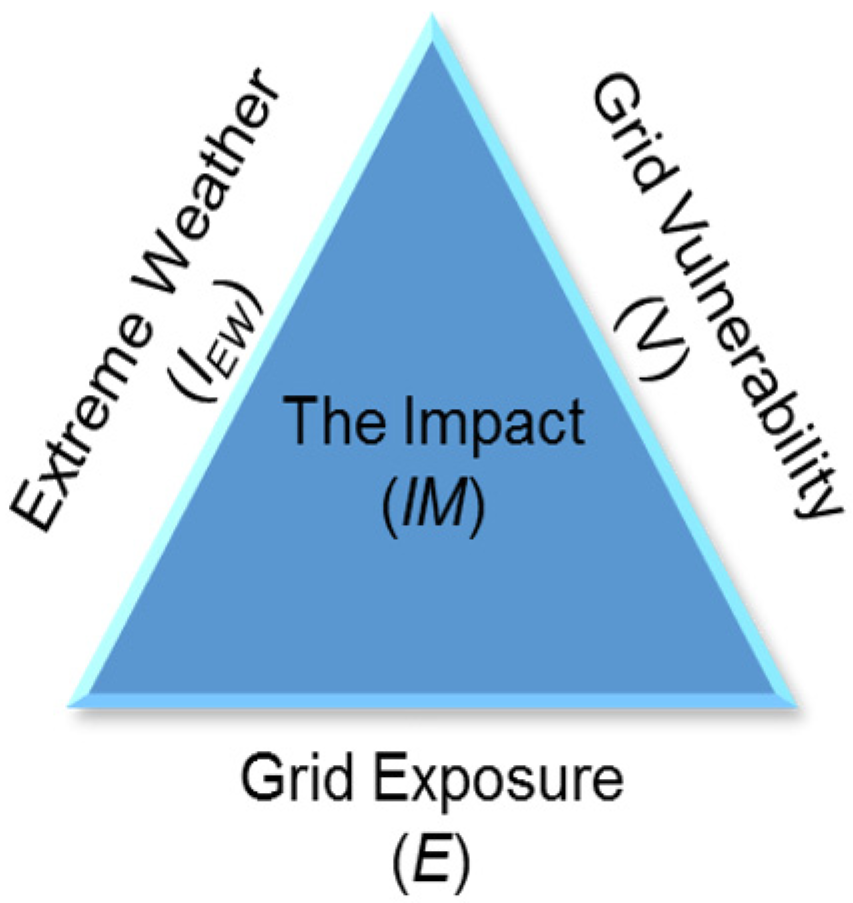
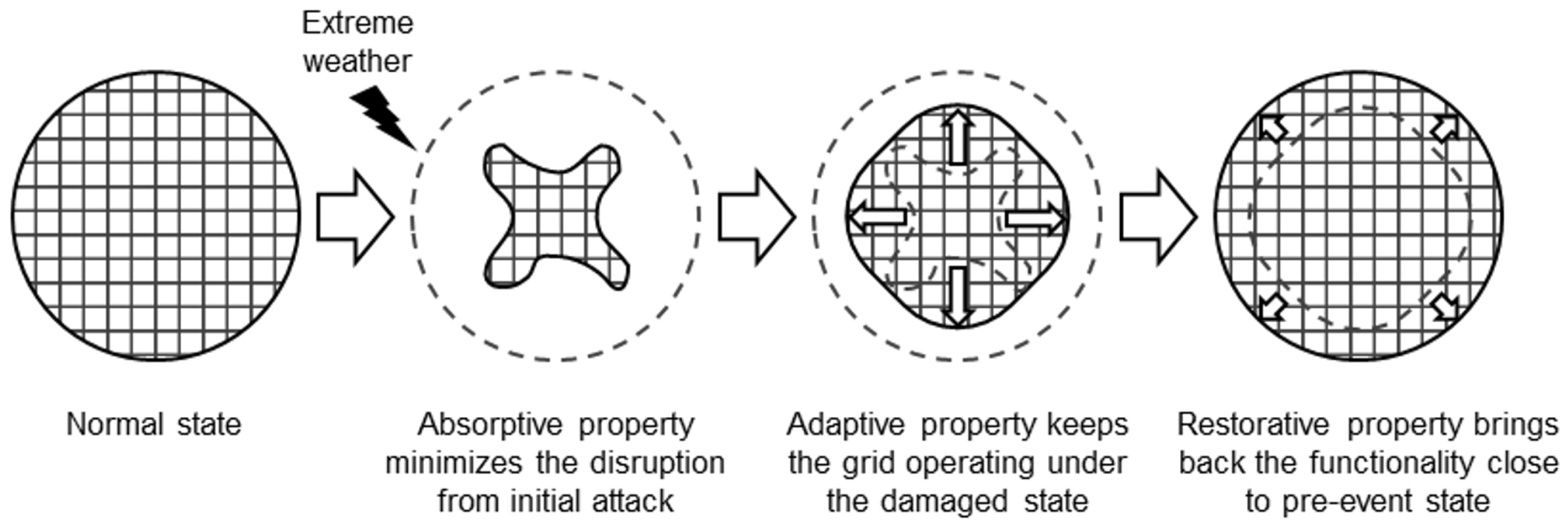
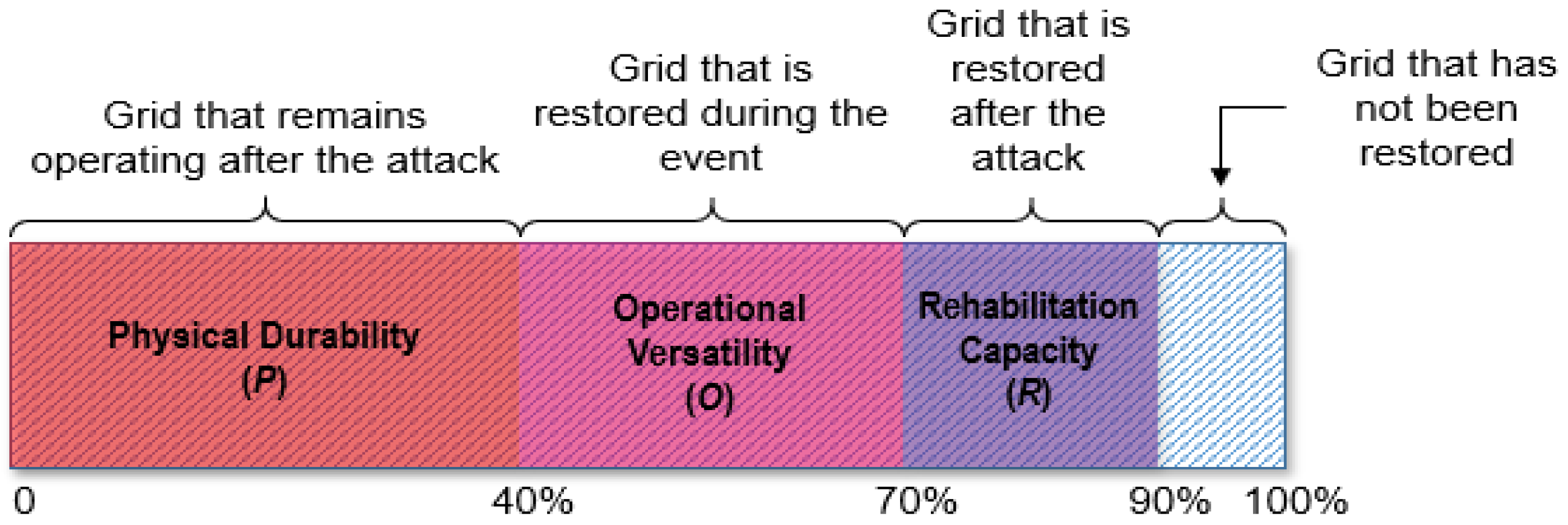
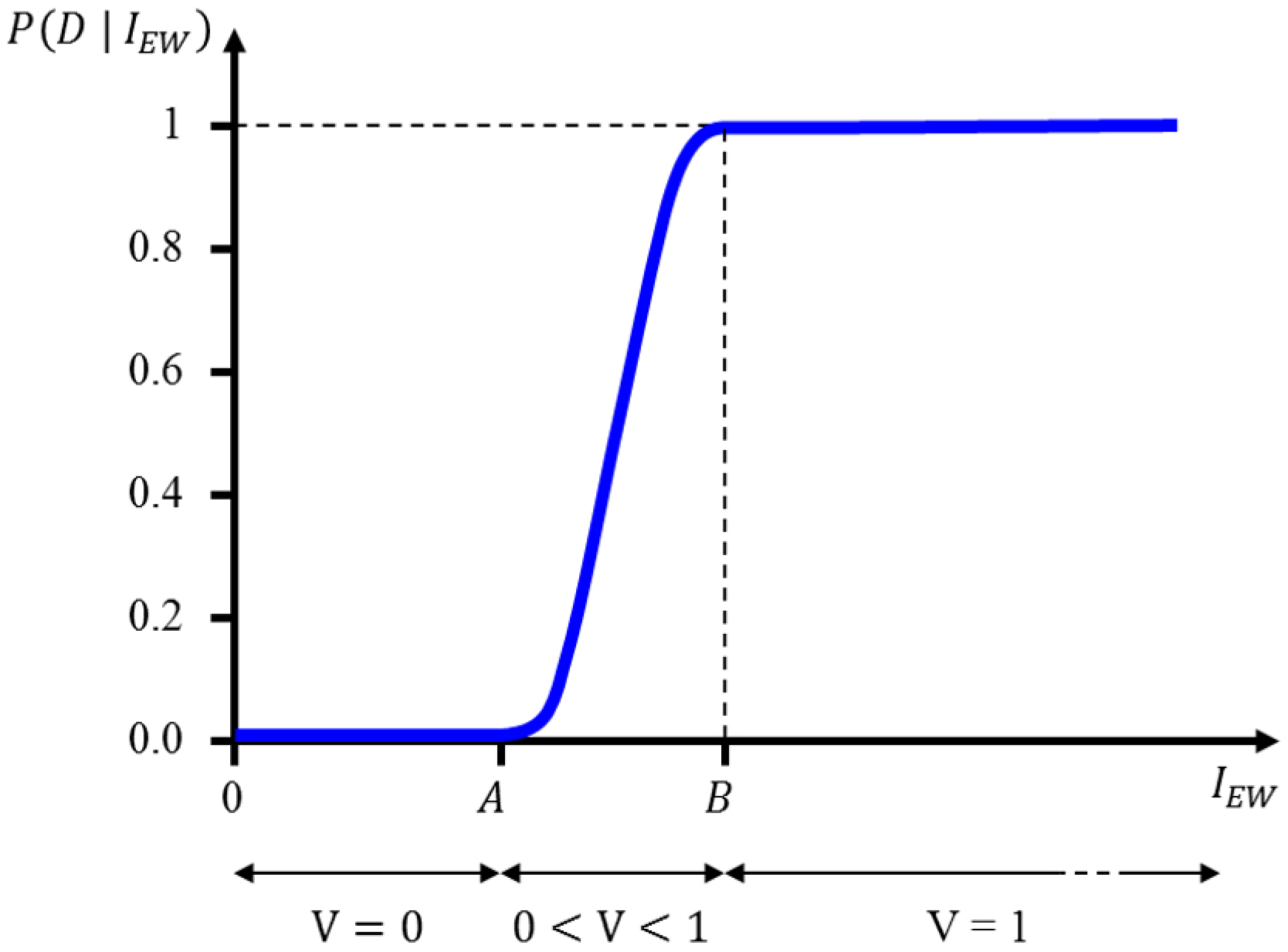
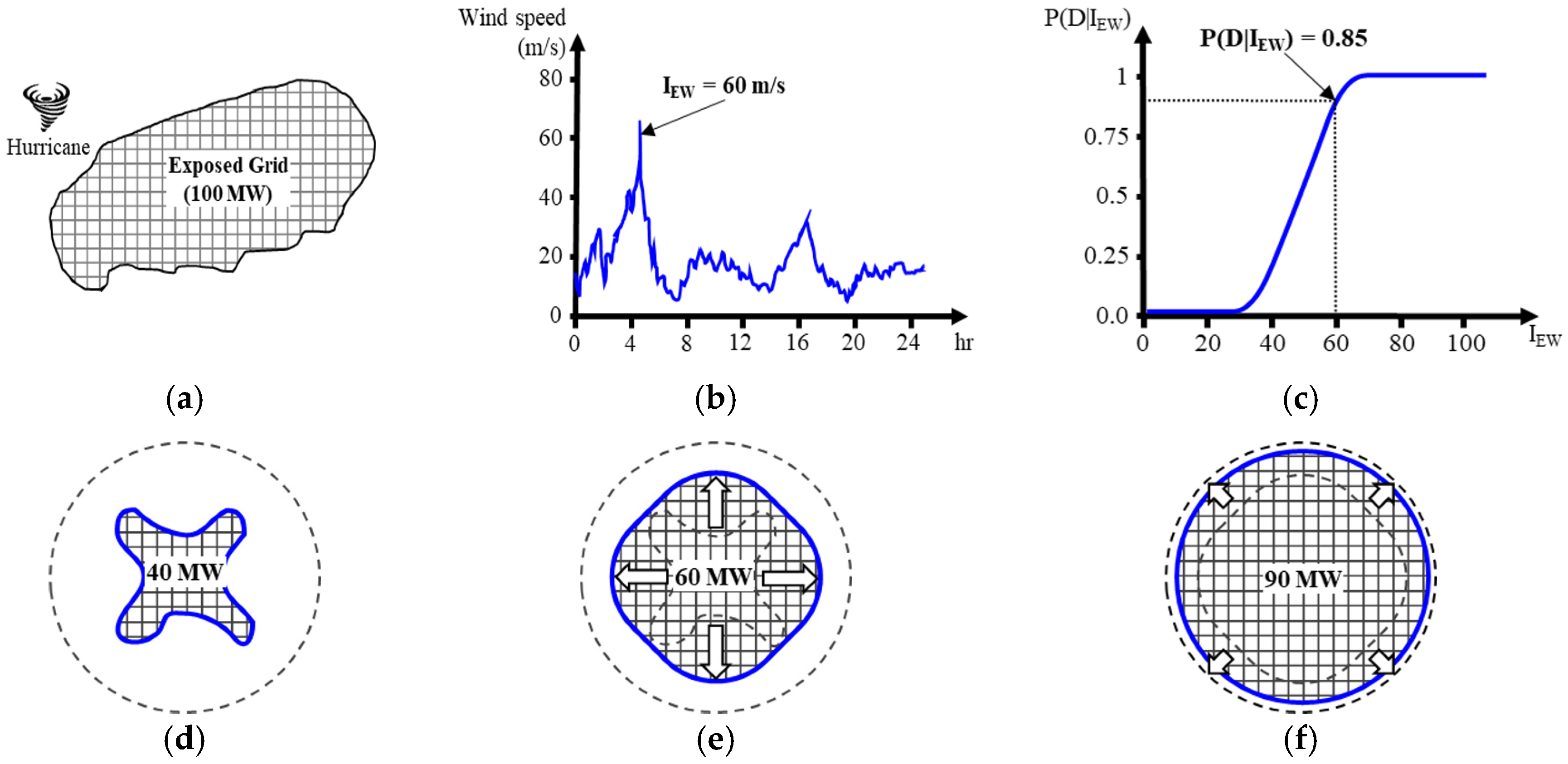
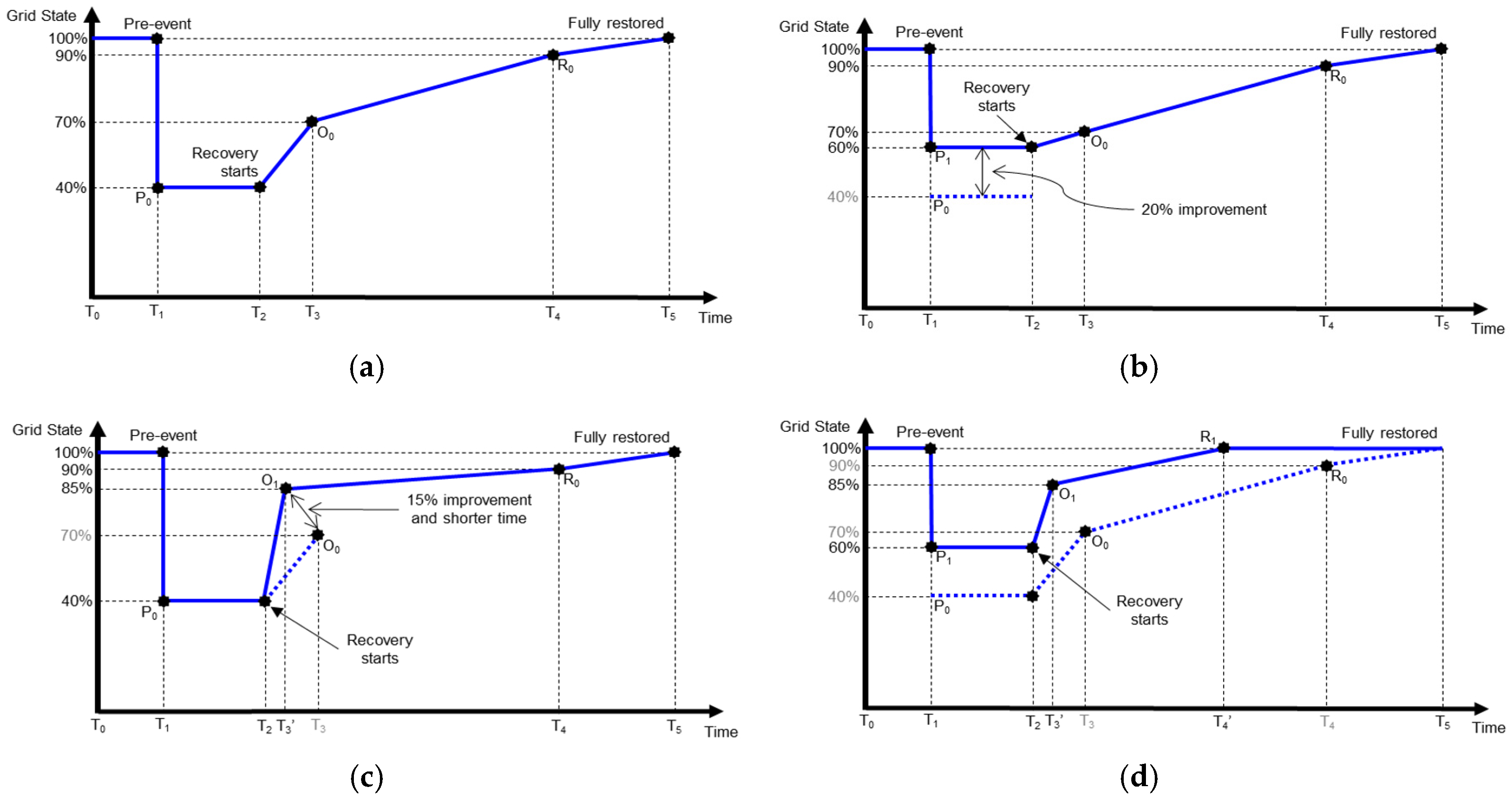
© 2017 by the authors. Licensee MDPI, Basel, Switzerland. This article is an open access article distributed under the terms and conditions of the Creative Commons Attribution (CC BY) license (http://creativecommons.org/licenses/by/4.0/).
Share and Cite
Jufri, F.H.; Kim, J.-S.; Jung, J. Analysis of Determinants of the Impact and the Grid Capability to Evaluate and Improve Grid Resilience from Extreme Weather Event. Energies 2017, 10, 1779. https://doi.org/10.3390/en10111779
Jufri FH, Kim J-S, Jung J. Analysis of Determinants of the Impact and the Grid Capability to Evaluate and Improve Grid Resilience from Extreme Weather Event. Energies. 2017; 10(11):1779. https://doi.org/10.3390/en10111779
Chicago/Turabian StyleJufri, Fauzan Hanif, Jun-Sung Kim, and Jaesung Jung. 2017. "Analysis of Determinants of the Impact and the Grid Capability to Evaluate and Improve Grid Resilience from Extreme Weather Event" Energies 10, no. 11: 1779. https://doi.org/10.3390/en10111779




